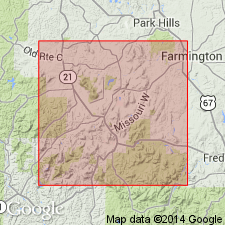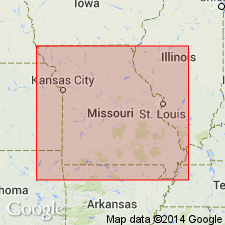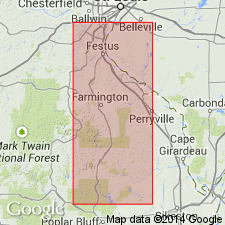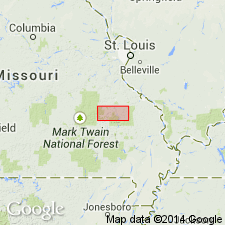
- Usage in publication:
-
- Stono granite
- Modifications:
-
- First used
- Dominant lithology:
-
- [Granite]
- AAPG geologic province:
-
- Midcontinent region
Summary:
Stono granite (new) of Musco group (new). Briefly summarized in report by W.C. Hayes, Precambrian rock units in Missouri, p. 83 (table 1), this volume. New names are credited to Tolman and Robertson (in prep.) [1969, Missouri Div. Geol. Survey Water Res. Rpt. Inv., no. 44 (Contrib. to Precambrian Geol., no. 1)]. Age is Precambrian.
Occurs in St. Francois Mountain area. Stono Mountain is in T. 35 N., R. 4 E., St. Francois Co., southeastern MO.
Source: Modified from US geologic names lexicon (USGS Bull. 1350, p. 726-727).

- Usage in publication:
-
- Stono granite
- Modifications:
-
- Principal reference
- Dominant lithology:
-
- Granite
- AAPG geologic province:
-
- Midcontinent region
Summary:
Pg. 36. Stono granite of Musco group. Fine-grained, mottled, dull reddish-brown and green granite, in places porphyritic. Contains principally light-red feldspar and inconspicuous quartz with small amounts of biotite and hornblende. Fresh outcrops are rare; weathers to light brownish-red color; alteration of mafic minerals to chlorite give clean surfaces a mottled greenish cast. Very similar to Slabtown granite of Musco group. Age is Precambrian.
Named from exposures on Stono Mountain, in sec. 25, T. 35 N., R. 4 E., St. Francois Co., MO.
Well exposed on south side of St. Francis River and along road east of Bismark, near common corner of secs 2, 3, 10, and 11, T. 35 N., R. 4 E., St. Francois Mountains, southeast MO. (Type locality not designated.)
See C.E. Robertson, 1995, Precambrian rocks, IN T.L. Thompson, Stratigraphic succession in Missouri (revised-1995), Missouri Division of Geology and Land Survey, 2nd series, v. 40 Revised, p. 5-14.
[GNU remark (Feb. 16, 1990, USGS DDS-6; Denver GNULEX): Stratigraphic relationships of units of Musco not discussed in text; geologic map (plate 1) missing from library copy of report.]
Source: Strat. succession in Missouri (Thompson, 1995, p. 13); GNU records (USGS DDS-6; Denver GNULEX).

- Usage in publication:
-
- Stono Granite
- Modifications:
-
- Revised
- AAPG geologic province:
-
- Midcontinent region
Summary:
Stono Granite (referred to in table 1 as "Slabtown-Stono Granites"), one of seven Precambrian Y plutonic rock units assigned to the /St. Francois Mountains Intrusive Suite (revised). [Previously assigned to Musco Group by Tolman and Robertson (1969); status of Musco not discussed.] Present in St. Francois Mountains, southeast Missouri (Midcontinent region). Younger than "Butler Hill-Breadtray Granites" (revised) of St. Francois Mountains; older than "Silvermine-Knoblick Granites" (revised) of St. Francois Mountains. Age is Precambrian Y. Nomenclature listed in table 1.
[Conflicts with nomenclature guidelines (ACSN, 1970; NACSN, 1983, 2005, 2021): name St. Francois Mountains applied concurrently to two different units in same area; name Butler Hill applied concurrently to two different units in same area.]
Source: Modified from GNU records (USGS DDS-6; Denver GNULEX).

- Usage in publication:
-
- Stono granite
- Modifications:
-
- Overview
- AAPG geologic province:
-
- Midcontinent region
Summary:
Mapped in central St. Francois Mountains, southeast MO, Midcontinent region. [Not clear if authors intended stratigraphic units within study area to be formal or informal.] Unit is fine-grained, gray to brown rock that occurs as small pluton located between Iron Mountain and Dow Run. Mapped undivided with low-silica plutons (which include Stono, Silvermine, Slabtown, and Knoblick Granites of Tolman and Robertson, 1969, and are mapped as "Ring Plutons of Butler Hill Caldera"). Low-silica plutons occur around margin of larger, high-silica Butler Hill granite (revised); contacts are not well enough exposed to determine intrusive relationships except that Butler Hill is intruded by Silvermine. Shown on map explanation to be younger than "Butler Hill-Breadtray Granite" map unit; older than "Hypabyssal Intrusives of Western St. Francois Mountains" map unit (which includes Munger Granite Porphyry and Carver Creek Granite of Tolman and Robertson, 1969). Everywhere that contacts are observed, plutonic rocks are younger than, and intrude, volcanic rocks of St. Francois Mountains. Proterozoic age.
[Authors' intentions are unclear as to which, if any, of the geologic units discussed should have formal status.]
Source: GNU records (USGS DDS-6; Denver GNULEX).
For more information, please contact Nancy Stamm, Geologic Names Committee Secretary.
Asterisk (*) indicates published by U.S. Geological Survey authors.
"No current usage" (†) implies that a name has been abandoned or has fallen into disuse. Former usage and, if known, replacement name given in parentheses ( ).
Slash (/) indicates name conflicts with nomenclatural guidelines (CSN, 1933; ACSN, 1961, 1970; NACSN, 1983, 2005, 2021). May be explained within brackets ([ ]).

